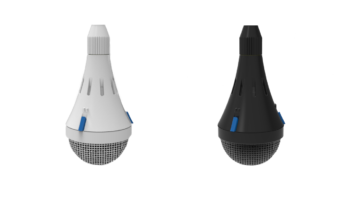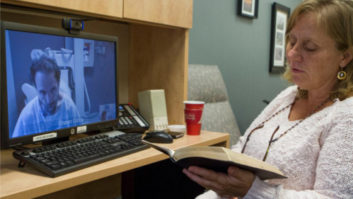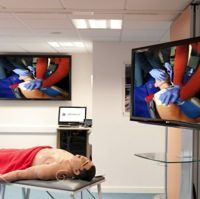After looking at the factors making telemedicine one of the fastest growing markets in AV, we consider how the technology is improving communication and aiding greater collaboration.
“Healthcare organisations today are looking for solutions that improve communications and collaboration across the entire healthcare delivery system for better decision-making, project management, efficiency, cost-savings and productivity,” notes Andrew Graley, director of healthcare, government and education, EMEA at Polycom. “Therefore, technologies such as unified communications continue to be in high demand within this sector.”
Collaboration is certainly key. “In every healthcare facility, the multidisciplinary team – MDT – rooms are always fully booked,” Michael Roach, UK business manager for healthcare at Involve Visual Collaboration points out. “Clinicians and specialists from various locations have a significant need to share not just opinions, but also information in the form of patient notes, X-rays, medical images, microscopy and so on. Appropriate telemedicine systems can greatly facilitate that.”
Videoconferencing with doctors?
Inevitably, much of the focus in telemedicine is on communication via video – either collaboration between healthcare professionals, or the facilitation of physician/patient interaction. For an integrator with existing experience and expertise in the field, it may seem like an interesting market to pursue. But: is it no more than videoconferencing with white coats and stethoscopes?
Unsurprisingly, the answer is ‘yes’ – and ‘no’.
“They’re totally different,” insists Ewan Marshall, co-founder and CEO of SpeakSet. “Corporate videoconferencing is designed for two businesses or employees to work together. Telemedicine is a very different beast, simply due to the nature of the clinician/patient relationship. Each side has very different needs to the other. One is at home; the other is at work. One is laying bare their deepest problems; the other is being professional. The packages that work will be ones that cater to the specific use case of each individual.”
“Videoconferencing is just one part of the overall solution when it comes to telemedicine,” says Richard Middleton, country manager for the UK and Ireland at Lifesize. “The solution needs to combine videoconferencing technology with email and other methods of communication and remote monitoring tools to allow doctors to assess, diagnose, treat and monitor patients remotely, rather than having to see them in person.”
“For a doctor to develop a diagnosis, conversation with the patient goes only so far,” adds Roger Downey, communications manager at US-based GlobalMed. “He or she needs objective information from a physical examination, and to get that you need the medical devices that would normally be used if the patient were present in the doctor’s office. That’s how telemedicine distinguishes itself from videoconferencing.”
Their points are amplified by Mark Noble, vice president, strategic marketing at video collaboration company Vidyo. “The telemedicine space is very broad and video communications is a small, albeit important, component,” he explains. “One goal of telemedicine practitioners is to reach the point where the ‘tele’ nomenclature is no longer necessary. From their perspective, they are practicing medicine. From a solution provider’s perspective, our role as an industry is to ensure that care providers have the tools they need to be as effective at a distance as they would be in person, and do so with a workflow that mirrors the in-person workflow as closely as possible so that the care provider doesn’t have to practise differently because of the delivery mechanism. As a result, we’ve seen the development of a robust ecosystem of products and technologies that can be integrated together, either physically or via APIs, to deliver specific workflows.”
“For manufacturers, it is essential to provide a platform that easily integrates with the ecosystem of healthcare solutions,” he goes on. “For integrators, it is necessary to focus on the workflow and craft solutions that closely mirror the in-person workflow. Combining these two practices will help ensure customers have successful deployments and grow their appetite for enabling more workflows via telemedicine.”
Workflow, integration
Noble mentions ‘workflow’ and ‘integrated’ – and those are words that crop up regularly in any discussion of telemedicine.
“Workflow is very important to physicians,” confirms Downey. “If it takes too long to set up or doesn’t work all the time, or it takes effort to learn how to use it, the equipment will gather dust in a closet. So ease of use is critical.”
“GlobalMed learned this early on and has continually tried to incorporate medical peripherals to enhance workflow, not impede it,” he says. “We recently launched a telemedicine platform called eNcounter which is intuitive. It begins with a single sign-on by the provider with the patient. eNcounter guides a provider through a patient session. Medical devices like an exam camera, digital stethoscope, ECG, ultrasound, vital signs monitor and so on work within the web-based software program and are available at any time by clicking on an icon.”
That apparent level of complexity may be seen as a deterrent, dissuading prospective integrators from even considering entry into the telemedicine market – although, as Noble pointed out, the important thing may not be to provide the complete system, but to offer an underlying platform that enables simple integration with the wider infrastructure.
SpeakSet video consultations
Polycom videoconferencing
Lifesize videoconferencing solutions
GlobalMed telemedicine solutions
Involve Visual Collaboration
Vidyo video collaboration






